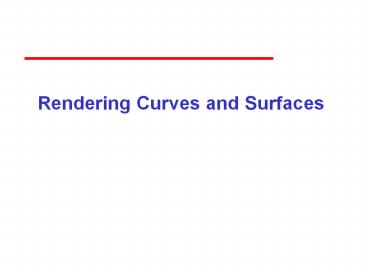Rendering Curves and Surfaces - PowerPoint PPT Presentation
Title:
Rendering Curves and Surfaces
Description:
Title: PowerPoint Presentation Author: Barbara Hecker Last modified by: Barbara Hecker Created Date: 8/2/2002 7:17:07 PM Document presentation format – PowerPoint PPT presentation
Number of Views:129
Avg rating:3.0/5.0
Title: Rendering Curves and Surfaces
1
Rendering Curves and Surfaces
2
Objectives
- Introduce methods to draw curves
- Approximate with lines
- Finite Differences
- Derive the recursive method for evaluation of
Bezier curves and surfaces - Learn how to convert all polynomial data to data
for Bezier polynomials
3
Evaluating Polynomials
- Simplest method to render a polynomial curve is
to evaluate the polynomial at many points and
form an approximating polyline - For surfaces we can form an approximating mesh of
triangles or quadrilaterals - Use Horners method to evaluate polynomials
- p(u)c0u(c1u(c2uc3))
- 3 multiplications/evaluation for cubic
4
Finite Differences
For equally spaced uk we define finite
differences
For a polynomial of degree n, the nth finite
difference is constant
5
Building a Finite Difference Table
- p(u)13u2u2u3
6
Finding the Next Values
- Starting at the bottom, we can work up generating
new values for the polynomial
7
deCasteljau Recursion
- We can use the convex hull property of Bezier
curves to obtain an efficient recursive method
that does not require any function evaluations - Uses only the values at the control points
- Based on the idea that any polynomial and any
part of a polynomial is a Bezier polynomial for
properly chosen control data
8
Splitting a Cubic Bezier
p0, p1 , p2 , p3 determine a cubic Bezier
polynomial and its convex hull
Consider left half l(u) and right half r(u)
9
l(u) and r(u)
Since l(u) and r(u) are Bezier curves, we should
be able to find two sets of control points l0,
l1, l2, l3 and r0, r1, r2, r3 that determine
them
10
Convex Hulls
l0, l1, l2, l3 and r0, r1, r2, r3each have a
convex hull that that is closer to p(u) than the
convex hull of p0, p1, p2, p3 This is known as
the variation diminishing property.
The polyline from l0 to l3 ( r0) to r3 is an
approximation to p(u). Repeating recursively we
get better approximations.
11
Equations
Start with Bezier equations p(u)uTMBp
l(u) must interpolate p(0) and p(1/2)
l(0) l0 p0 l(1) l3 p(1/2) 1/8( p0 3 p1
3 p2 p3 )
Matching slopes, taking into account that l(u)
and r(u) only go over half the distance as p(u)
l(0) 3(l1 - l0) p(0) 3/2(p1 - p0 ) l(1)
3(l3 l2) p(1/2) 3/8(- p0 - p1 p2 p3)
Symmetric equations hold for r(u)
12
Efficient Form
l0 p0 r3 p3 l1 ½(p0 p1) r1 ½(p2
p3) l2 ½(l1 ½( p1 p2)) r1 ½(r2 ½( p1
p2)) l3 r0 ½(l2 r1)
Requires only shifts and adds!
13
Every Curve is a Bezier Curve
- We can render a given polynomial using the
recursive method if we find control points for
its representation as a Bezier curve - Suppose that p(u) is given as an interpolating
curve with control points q - There exist Bezier control points p such that
- Equating and solving, we find pMB-1MI
p(u)uTMIq
p(u)uTMBp
14
Matrices
Interpolating to Bezier
B-Spline to Bezier
15
Example
These three curves were all generated from the
same original data using Bezier recursion by
converting all control point data to Bezier
control points
Bezier
B Spline
Interpolating
16
Surfaces
- Can apply the recursive method to surfaces if we
recall that for a Bezier patch curves of constant
u (or v) are Bezier curves in u (or v) - First subdivide in u
- Process creates new points
- Some of the original points are discarded
original and discarded
original and kept
new
17
Second Subdivision
16 final points for 1 of 4 patches created
18
Normals
- For rendering we need the normals if we want to
shade - Can compute from parametric equations
- Can use vertices of corner points to determine
- OpenGL can compute automatically
19
Utah Teapot
- Most famous data set in computer graphics
- Widely available as a list of 306 3D vertices and
the indices that define 32 Bezier patches
20
Quadrics
- Any quadric can be written as the quadratic form
- pTApbTpc0 where px, y, zT
- with A, b and c giving the coefficients
- Render by ray casting
- Intersect with parametric ray p(a)p0ad that
passes through a pixel - Yields a scalar quadratic equation
- No solution ray misses quadric
- One solution ray tangent to quadric
- Two solutions entry and exit points































